A Critical Analysis of Bullying Policies in Australian Schools
VerifiedAdded on 2023/01/18
|13
|3298
|70
Essay
AI Summary
This essay provides a comprehensive analysis of bullying in Australian schools, focusing on the existing policies and their effectiveness in addressing the issue. The essay explores the nuances of bullying, including the rise of cyberbullying and its impact on students. It examines the limitations of current policies, highlighting the need for a more nuanced approach that considers the emotional and psychological effects on victims. The author investigates the challenges in defining bullying across different legal frameworks and emphasizes the importance of well-being-focused policies. The essay also discusses the role of school authorities, the need for clear guidelines, and the importance of educating students about responsible social media use. Ultimately, the essay proposes actions such as defining cyberbullying, promoting ethical behavior, and providing value education to create a safer and more supportive environment for students. This document is provided by a student and is available on Desklib, a platform offering AI-powered study tools.
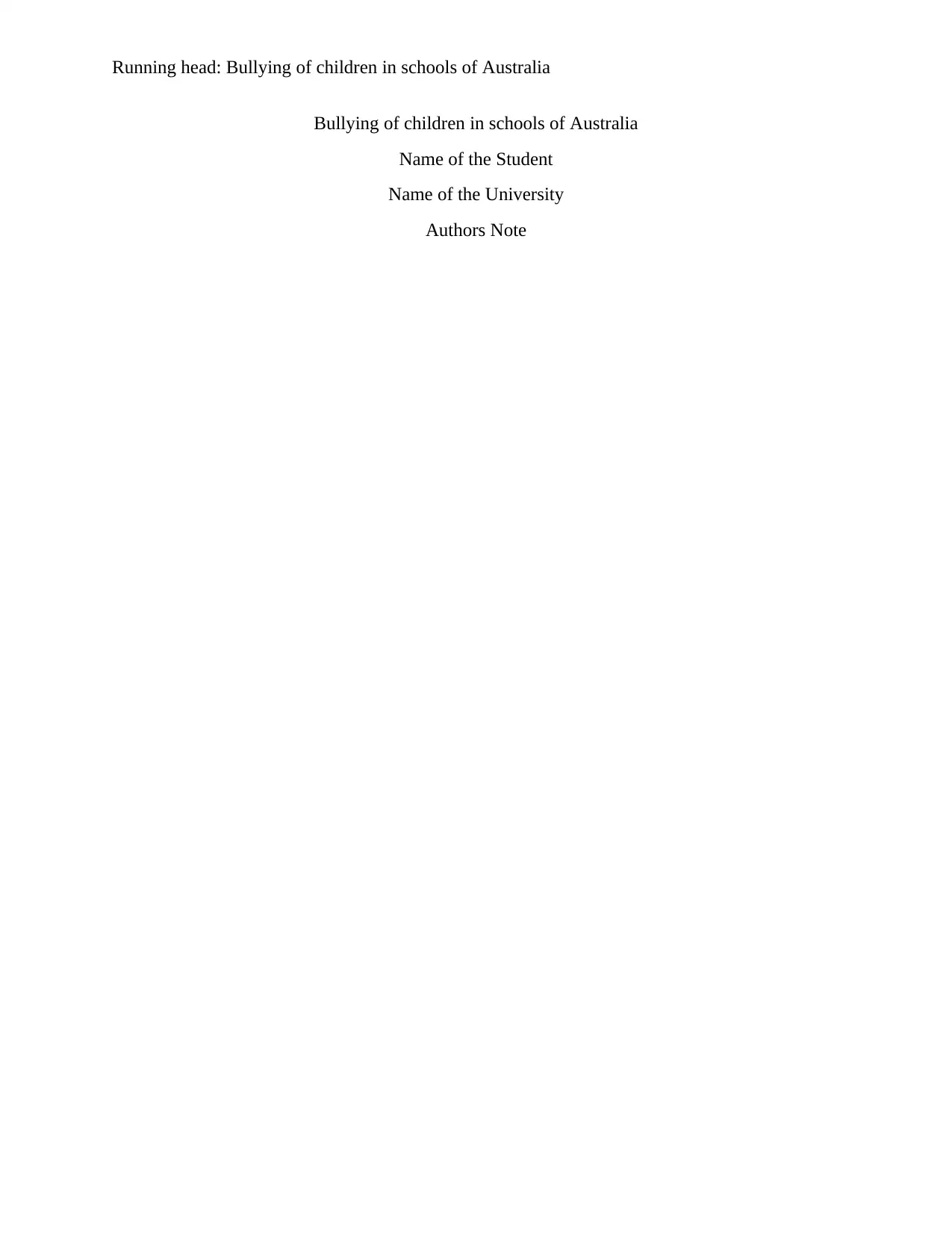
Running head: Bullying of children in schools of Australia
Bullying of children in schools of Australia
Name of the Student
Name of the University
Authors Note
Bullying of children in schools of Australia
Name of the Student
Name of the University
Authors Note
Paraphrase This Document
Need a fresh take? Get an instant paraphrase of this document with our AI Paraphraser
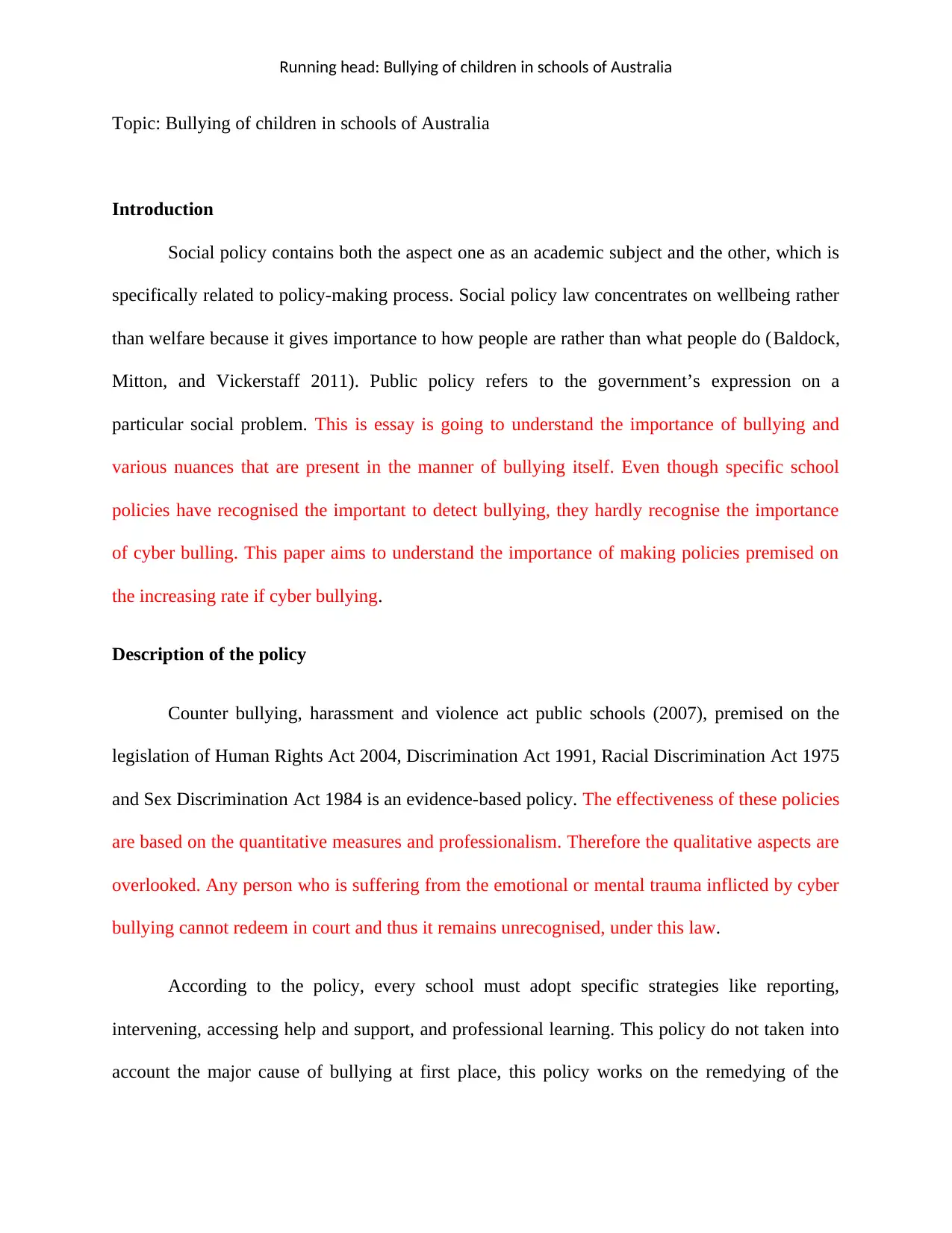
Running head: Bullying of children in schools of Australia
Topic: Bullying of children in schools of Australia
Introduction
Social policy contains both the aspect one as an academic subject and the other, which is
specifically related to policy-making process. Social policy law concentrates on wellbeing rather
than welfare because it gives importance to how people are rather than what people do (Baldock,
Mitton, and Vickerstaff 2011). Public policy refers to the government’s expression on a
particular social problem. This is essay is going to understand the importance of bullying and
various nuances that are present in the manner of bullying itself. Even though specific school
policies have recognised the important to detect bullying, they hardly recognise the importance
of cyber bulling. This paper aims to understand the importance of making policies premised on
the increasing rate if cyber bullying.
Description of the policy
Counter bullying, harassment and violence act public schools (2007), premised on the
legislation of Human Rights Act 2004, Discrimination Act 1991, Racial Discrimination Act 1975
and Sex Discrimination Act 1984 is an evidence-based policy. The effectiveness of these policies
are based on the quantitative measures and professionalism. Therefore the qualitative aspects are
overlooked. Any person who is suffering from the emotional or mental trauma inflicted by cyber
bullying cannot redeem in court and thus it remains unrecognised, under this law.
According to the policy, every school must adopt specific strategies like reporting,
intervening, accessing help and support, and professional learning. This policy do not taken into
account the major cause of bullying at first place, this policy works on the remedying of the
Topic: Bullying of children in schools of Australia
Introduction
Social policy contains both the aspect one as an academic subject and the other, which is
specifically related to policy-making process. Social policy law concentrates on wellbeing rather
than welfare because it gives importance to how people are rather than what people do (Baldock,
Mitton, and Vickerstaff 2011). Public policy refers to the government’s expression on a
particular social problem. This is essay is going to understand the importance of bullying and
various nuances that are present in the manner of bullying itself. Even though specific school
policies have recognised the important to detect bullying, they hardly recognise the importance
of cyber bulling. This paper aims to understand the importance of making policies premised on
the increasing rate if cyber bullying.
Description of the policy
Counter bullying, harassment and violence act public schools (2007), premised on the
legislation of Human Rights Act 2004, Discrimination Act 1991, Racial Discrimination Act 1975
and Sex Discrimination Act 1984 is an evidence-based policy. The effectiveness of these policies
are based on the quantitative measures and professionalism. Therefore the qualitative aspects are
overlooked. Any person who is suffering from the emotional or mental trauma inflicted by cyber
bullying cannot redeem in court and thus it remains unrecognised, under this law.
According to the policy, every school must adopt specific strategies like reporting,
intervening, accessing help and support, and professional learning. This policy do not taken into
account the major cause of bullying at first place, this policy works on the remedying of the
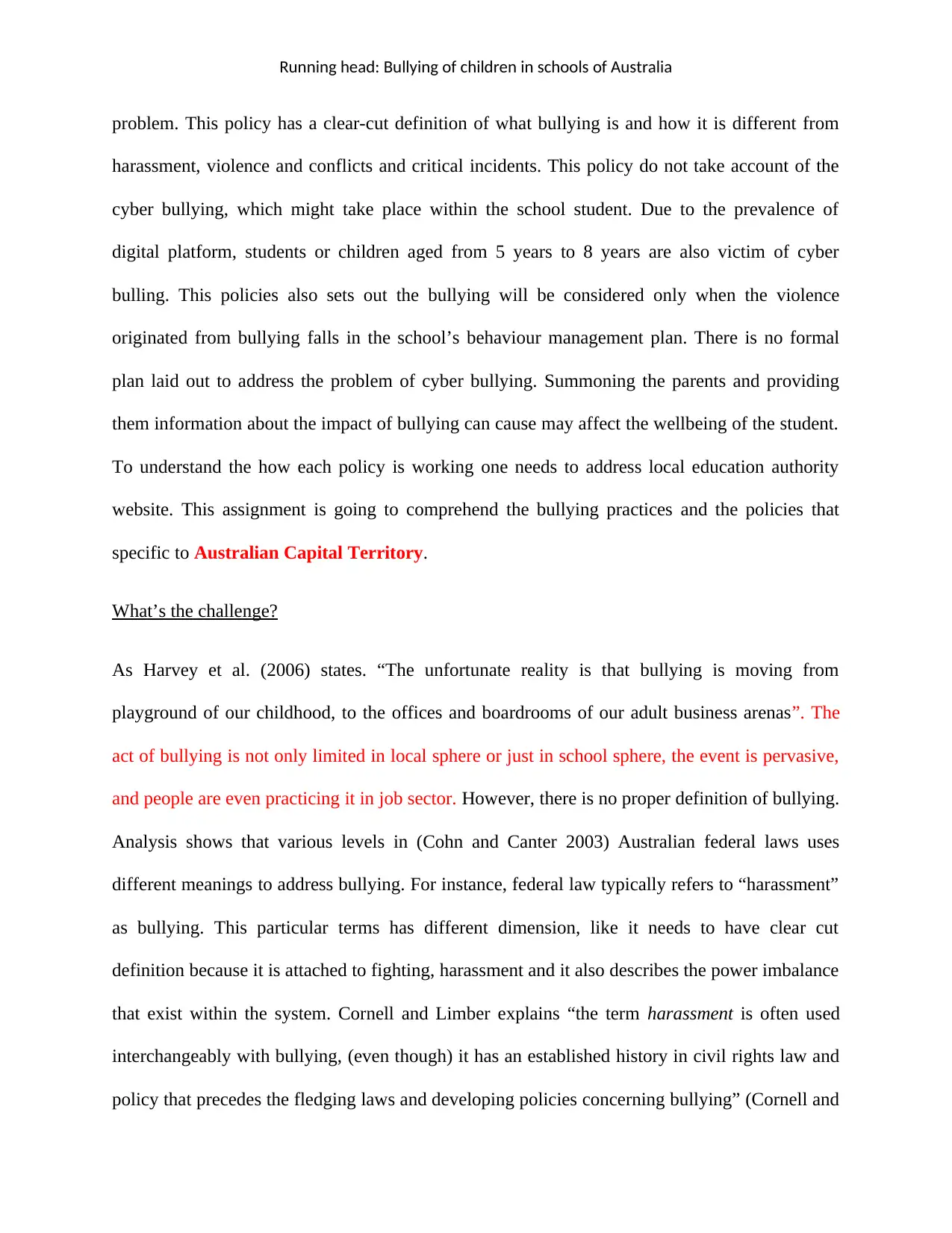
Running head: Bullying of children in schools of Australia
problem. This policy has a clear-cut definition of what bullying is and how it is different from
harassment, violence and conflicts and critical incidents. This policy do not take account of the
cyber bullying, which might take place within the school student. Due to the prevalence of
digital platform, students or children aged from 5 years to 8 years are also victim of cyber
bulling. This policies also sets out the bullying will be considered only when the violence
originated from bullying falls in the school’s behaviour management plan. There is no formal
plan laid out to address the problem of cyber bullying. Summoning the parents and providing
them information about the impact of bullying can cause may affect the wellbeing of the student.
To understand the how each policy is working one needs to address local education authority
website. This assignment is going to comprehend the bullying practices and the policies that
specific to Australian Capital Territory.
What’s the challenge?
As Harvey et al. (2006) states. “The unfortunate reality is that bullying is moving from
playground of our childhood, to the offices and boardrooms of our adult business arenas”. The
act of bullying is not only limited in local sphere or just in school sphere, the event is pervasive,
and people are even practicing it in job sector. However, there is no proper definition of bullying.
Analysis shows that various levels in (Cohn and Canter 2003) Australian federal laws uses
different meanings to address bullying. For instance, federal law typically refers to “harassment”
as bullying. This particular terms has different dimension, like it needs to have clear cut
definition because it is attached to fighting, harassment and it also describes the power imbalance
that exist within the system. Cornell and Limber explains “the term harassment is often used
interchangeably with bullying, (even though) it has an established history in civil rights law and
policy that precedes the fledging laws and developing policies concerning bullying” (Cornell and
problem. This policy has a clear-cut definition of what bullying is and how it is different from
harassment, violence and conflicts and critical incidents. This policy do not take account of the
cyber bullying, which might take place within the school student. Due to the prevalence of
digital platform, students or children aged from 5 years to 8 years are also victim of cyber
bulling. This policies also sets out the bullying will be considered only when the violence
originated from bullying falls in the school’s behaviour management plan. There is no formal
plan laid out to address the problem of cyber bullying. Summoning the parents and providing
them information about the impact of bullying can cause may affect the wellbeing of the student.
To understand the how each policy is working one needs to address local education authority
website. This assignment is going to comprehend the bullying practices and the policies that
specific to Australian Capital Territory.
What’s the challenge?
As Harvey et al. (2006) states. “The unfortunate reality is that bullying is moving from
playground of our childhood, to the offices and boardrooms of our adult business arenas”. The
act of bullying is not only limited in local sphere or just in school sphere, the event is pervasive,
and people are even practicing it in job sector. However, there is no proper definition of bullying.
Analysis shows that various levels in (Cohn and Canter 2003) Australian federal laws uses
different meanings to address bullying. For instance, federal law typically refers to “harassment”
as bullying. This particular terms has different dimension, like it needs to have clear cut
definition because it is attached to fighting, harassment and it also describes the power imbalance
that exist within the system. Cornell and Limber explains “the term harassment is often used
interchangeably with bullying, (even though) it has an established history in civil rights law and
policy that precedes the fledging laws and developing policies concerning bullying” (Cornell and
⊘ This is a preview!⊘
Do you want full access?
Subscribe today to unlock all pages.

Trusted by 1+ million students worldwide
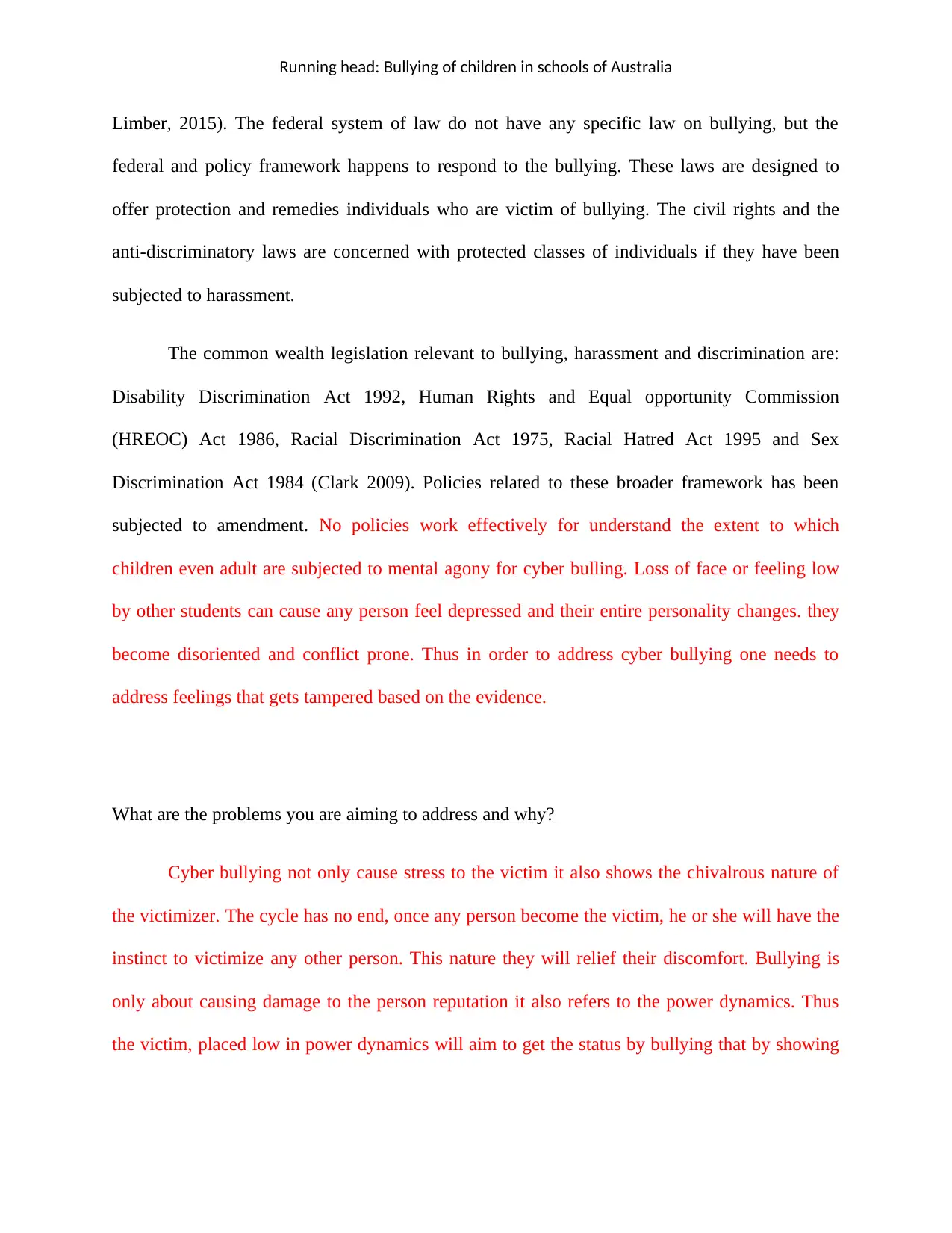
Running head: Bullying of children in schools of Australia
Limber, 2015). The federal system of law do not have any specific law on bullying, but the
federal and policy framework happens to respond to the bullying. These laws are designed to
offer protection and remedies individuals who are victim of bullying. The civil rights and the
anti-discriminatory laws are concerned with protected classes of individuals if they have been
subjected to harassment.
The common wealth legislation relevant to bullying, harassment and discrimination are:
Disability Discrimination Act 1992, Human Rights and Equal opportunity Commission
(HREOC) Act 1986, Racial Discrimination Act 1975, Racial Hatred Act 1995 and Sex
Discrimination Act 1984 (Clark 2009). Policies related to these broader framework has been
subjected to amendment. No policies work effectively for understand the extent to which
children even adult are subjected to mental agony for cyber bulling. Loss of face or feeling low
by other students can cause any person feel depressed and their entire personality changes. they
become disoriented and conflict prone. Thus in order to address cyber bullying one needs to
address feelings that gets tampered based on the evidence.
What are the problems you are aiming to address and why?
Cyber bullying not only cause stress to the victim it also shows the chivalrous nature of
the victimizer. The cycle has no end, once any person become the victim, he or she will have the
instinct to victimize any other person. This nature they will relief their discomfort. Bullying is
only about causing damage to the person reputation it also refers to the power dynamics. Thus
the victim, placed low in power dynamics will aim to get the status by bullying that by showing
Limber, 2015). The federal system of law do not have any specific law on bullying, but the
federal and policy framework happens to respond to the bullying. These laws are designed to
offer protection and remedies individuals who are victim of bullying. The civil rights and the
anti-discriminatory laws are concerned with protected classes of individuals if they have been
subjected to harassment.
The common wealth legislation relevant to bullying, harassment and discrimination are:
Disability Discrimination Act 1992, Human Rights and Equal opportunity Commission
(HREOC) Act 1986, Racial Discrimination Act 1975, Racial Hatred Act 1995 and Sex
Discrimination Act 1984 (Clark 2009). Policies related to these broader framework has been
subjected to amendment. No policies work effectively for understand the extent to which
children even adult are subjected to mental agony for cyber bulling. Loss of face or feeling low
by other students can cause any person feel depressed and their entire personality changes. they
become disoriented and conflict prone. Thus in order to address cyber bullying one needs to
address feelings that gets tampered based on the evidence.
What are the problems you are aiming to address and why?
Cyber bullying not only cause stress to the victim it also shows the chivalrous nature of
the victimizer. The cycle has no end, once any person become the victim, he or she will have the
instinct to victimize any other person. This nature they will relief their discomfort. Bullying is
only about causing damage to the person reputation it also refers to the power dynamics. Thus
the victim, placed low in power dynamics will aim to get the status by bullying that by showing
Paraphrase This Document
Need a fresh take? Get an instant paraphrase of this document with our AI Paraphraser
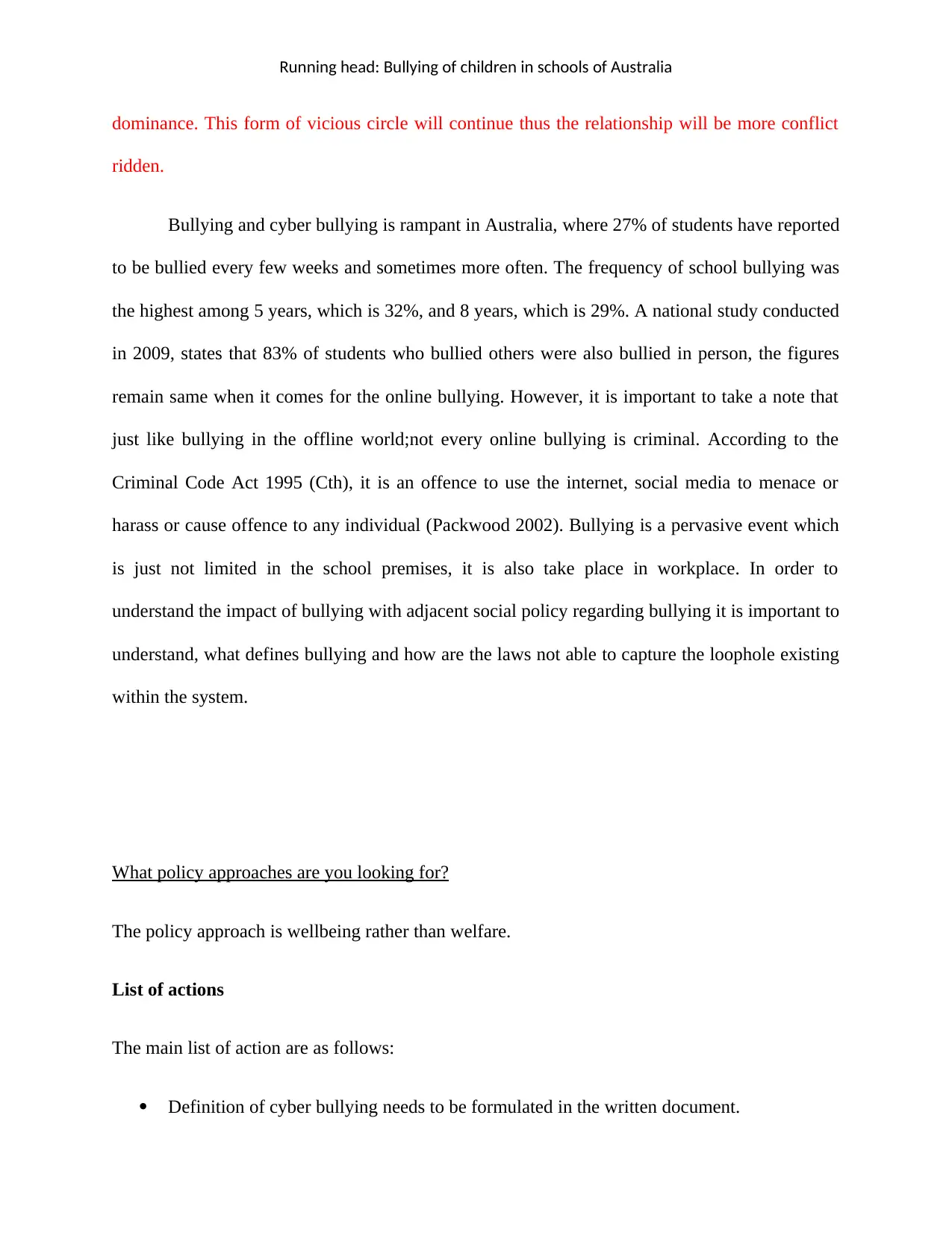
Running head: Bullying of children in schools of Australia
dominance. This form of vicious circle will continue thus the relationship will be more conflict
ridden.
Bullying and cyber bullying is rampant in Australia, where 27% of students have reported
to be bullied every few weeks and sometimes more often. The frequency of school bullying was
the highest among 5 years, which is 32%, and 8 years, which is 29%. A national study conducted
in 2009, states that 83% of students who bullied others were also bullied in person, the figures
remain same when it comes for the online bullying. However, it is important to take a note that
just like bullying in the offline world;not every online bullying is criminal. According to the
Criminal Code Act 1995 (Cth), it is an offence to use the internet, social media to menace or
harass or cause offence to any individual (Packwood 2002). Bullying is a pervasive event which
is just not limited in the school premises, it is also take place in workplace. In order to
understand the impact of bullying with adjacent social policy regarding bullying it is important to
understand, what defines bullying and how are the laws not able to capture the loophole existing
within the system.
What policy approaches are you looking for?
The policy approach is wellbeing rather than welfare.
List of actions
The main list of action are as follows:
Definition of cyber bullying needs to be formulated in the written document.
dominance. This form of vicious circle will continue thus the relationship will be more conflict
ridden.
Bullying and cyber bullying is rampant in Australia, where 27% of students have reported
to be bullied every few weeks and sometimes more often. The frequency of school bullying was
the highest among 5 years, which is 32%, and 8 years, which is 29%. A national study conducted
in 2009, states that 83% of students who bullied others were also bullied in person, the figures
remain same when it comes for the online bullying. However, it is important to take a note that
just like bullying in the offline world;not every online bullying is criminal. According to the
Criminal Code Act 1995 (Cth), it is an offence to use the internet, social media to menace or
harass or cause offence to any individual (Packwood 2002). Bullying is a pervasive event which
is just not limited in the school premises, it is also take place in workplace. In order to
understand the impact of bullying with adjacent social policy regarding bullying it is important to
understand, what defines bullying and how are the laws not able to capture the loophole existing
within the system.
What policy approaches are you looking for?
The policy approach is wellbeing rather than welfare.
List of actions
The main list of action are as follows:
Definition of cyber bullying needs to be formulated in the written document.
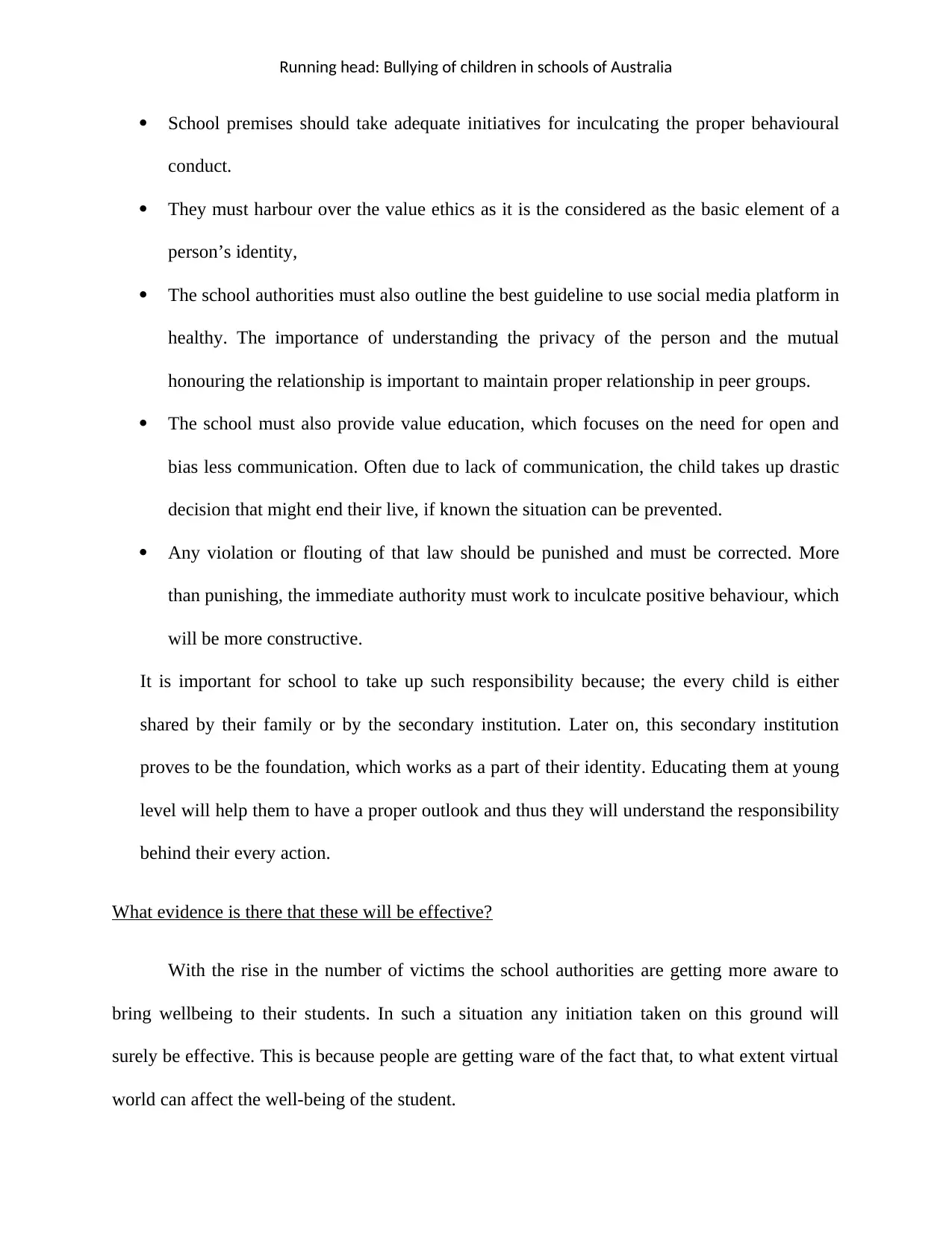
Running head: Bullying of children in schools of Australia
School premises should take adequate initiatives for inculcating the proper behavioural
conduct.
They must harbour over the value ethics as it is the considered as the basic element of a
person’s identity,
The school authorities must also outline the best guideline to use social media platform in
healthy. The importance of understanding the privacy of the person and the mutual
honouring the relationship is important to maintain proper relationship in peer groups.
The school must also provide value education, which focuses on the need for open and
bias less communication. Often due to lack of communication, the child takes up drastic
decision that might end their live, if known the situation can be prevented.
Any violation or flouting of that law should be punished and must be corrected. More
than punishing, the immediate authority must work to inculcate positive behaviour, which
will be more constructive.
It is important for school to take up such responsibility because; the every child is either
shared by their family or by the secondary institution. Later on, this secondary institution
proves to be the foundation, which works as a part of their identity. Educating them at young
level will help them to have a proper outlook and thus they will understand the responsibility
behind their every action.
What evidence is there that these will be effective?
With the rise in the number of victims the school authorities are getting more aware to
bring wellbeing to their students. In such a situation any initiation taken on this ground will
surely be effective. This is because people are getting ware of the fact that, to what extent virtual
world can affect the well-being of the student.
School premises should take adequate initiatives for inculcating the proper behavioural
conduct.
They must harbour over the value ethics as it is the considered as the basic element of a
person’s identity,
The school authorities must also outline the best guideline to use social media platform in
healthy. The importance of understanding the privacy of the person and the mutual
honouring the relationship is important to maintain proper relationship in peer groups.
The school must also provide value education, which focuses on the need for open and
bias less communication. Often due to lack of communication, the child takes up drastic
decision that might end their live, if known the situation can be prevented.
Any violation or flouting of that law should be punished and must be corrected. More
than punishing, the immediate authority must work to inculcate positive behaviour, which
will be more constructive.
It is important for school to take up such responsibility because; the every child is either
shared by their family or by the secondary institution. Later on, this secondary institution
proves to be the foundation, which works as a part of their identity. Educating them at young
level will help them to have a proper outlook and thus they will understand the responsibility
behind their every action.
What evidence is there that these will be effective?
With the rise in the number of victims the school authorities are getting more aware to
bring wellbeing to their students. In such a situation any initiation taken on this ground will
surely be effective. This is because people are getting ware of the fact that, to what extent virtual
world can affect the well-being of the student.
⊘ This is a preview!⊘
Do you want full access?
Subscribe today to unlock all pages.

Trusted by 1+ million students worldwide
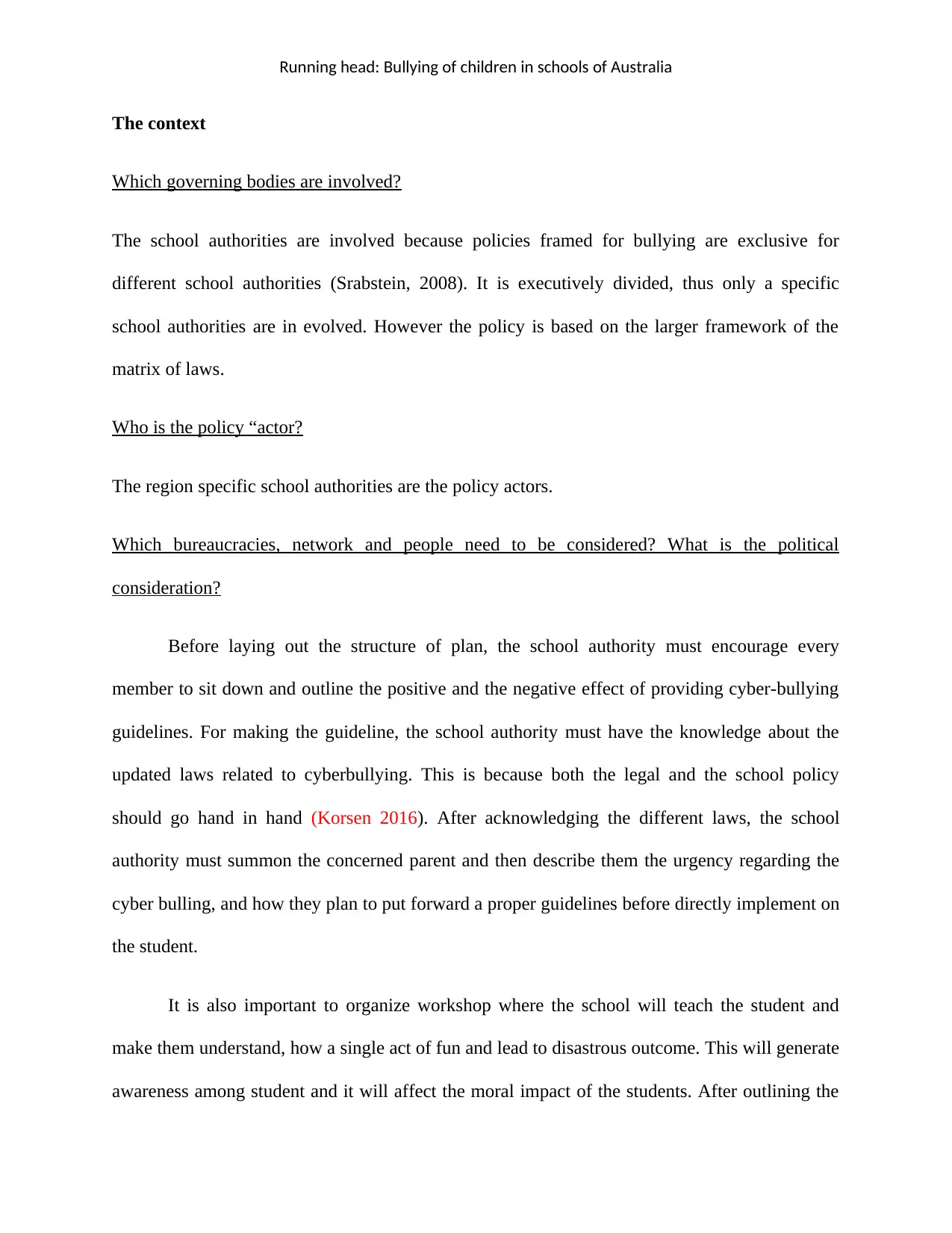
Running head: Bullying of children in schools of Australia
The context
Which governing bodies are involved?
The school authorities are involved because policies framed for bullying are exclusive for
different school authorities (Srabstein, 2008). It is executively divided, thus only a specific
school authorities are in evolved. However the policy is based on the larger framework of the
matrix of laws.
Who is the policy “actor?
The region specific school authorities are the policy actors.
Which bureaucracies, network and people need to be considered? What is the political
consideration?
Before laying out the structure of plan, the school authority must encourage every
member to sit down and outline the positive and the negative effect of providing cyber-bullying
guidelines. For making the guideline, the school authority must have the knowledge about the
updated laws related to cyberbullying. This is because both the legal and the school policy
should go hand in hand (Korsen 2016). After acknowledging the different laws, the school
authority must summon the concerned parent and then describe them the urgency regarding the
cyber bulling, and how they plan to put forward a proper guidelines before directly implement on
the student.
It is also important to organize workshop where the school will teach the student and
make them understand, how a single act of fun and lead to disastrous outcome. This will generate
awareness among student and it will affect the moral impact of the students. After outlining the
The context
Which governing bodies are involved?
The school authorities are involved because policies framed for bullying are exclusive for
different school authorities (Srabstein, 2008). It is executively divided, thus only a specific
school authorities are in evolved. However the policy is based on the larger framework of the
matrix of laws.
Who is the policy “actor?
The region specific school authorities are the policy actors.
Which bureaucracies, network and people need to be considered? What is the political
consideration?
Before laying out the structure of plan, the school authority must encourage every
member to sit down and outline the positive and the negative effect of providing cyber-bullying
guidelines. For making the guideline, the school authority must have the knowledge about the
updated laws related to cyberbullying. This is because both the legal and the school policy
should go hand in hand (Korsen 2016). After acknowledging the different laws, the school
authority must summon the concerned parent and then describe them the urgency regarding the
cyber bulling, and how they plan to put forward a proper guidelines before directly implement on
the student.
It is also important to organize workshop where the school will teach the student and
make them understand, how a single act of fun and lead to disastrous outcome. This will generate
awareness among student and it will affect the moral impact of the students. After outlining the
Paraphrase This Document
Need a fresh take? Get an instant paraphrase of this document with our AI Paraphraser
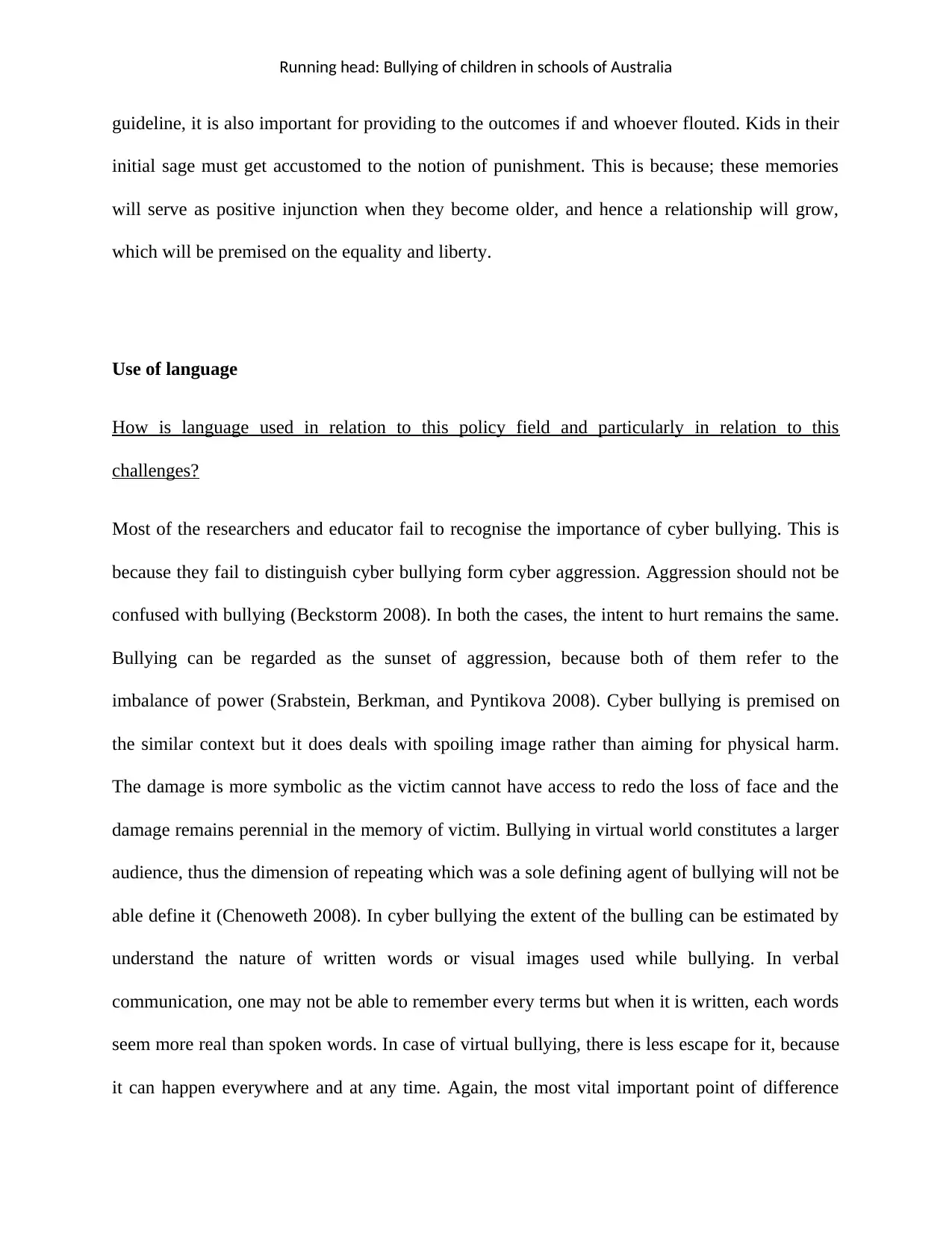
Running head: Bullying of children in schools of Australia
guideline, it is also important for providing to the outcomes if and whoever flouted. Kids in their
initial sage must get accustomed to the notion of punishment. This is because; these memories
will serve as positive injunction when they become older, and hence a relationship will grow,
which will be premised on the equality and liberty.
Use of language
How is language used in relation to this policy field and particularly in relation to this
challenges?
Most of the researchers and educator fail to recognise the importance of cyber bullying. This is
because they fail to distinguish cyber bullying form cyber aggression. Aggression should not be
confused with bullying (Beckstorm 2008). In both the cases, the intent to hurt remains the same.
Bullying can be regarded as the sunset of aggression, because both of them refer to the
imbalance of power (Srabstein, Berkman, and Pyntikova 2008). Cyber bullying is premised on
the similar context but it does deals with spoiling image rather than aiming for physical harm.
The damage is more symbolic as the victim cannot have access to redo the loss of face and the
damage remains perennial in the memory of victim. Bullying in virtual world constitutes a larger
audience, thus the dimension of repeating which was a sole defining agent of bullying will not be
able define it (Chenoweth 2008). In cyber bullying the extent of the bulling can be estimated by
understand the nature of written words or visual images used while bullying. In verbal
communication, one may not be able to remember every terms but when it is written, each words
seem more real than spoken words. In case of virtual bullying, there is less escape for it, because
it can happen everywhere and at any time. Again, the most vital important point of difference
guideline, it is also important for providing to the outcomes if and whoever flouted. Kids in their
initial sage must get accustomed to the notion of punishment. This is because; these memories
will serve as positive injunction when they become older, and hence a relationship will grow,
which will be premised on the equality and liberty.
Use of language
How is language used in relation to this policy field and particularly in relation to this
challenges?
Most of the researchers and educator fail to recognise the importance of cyber bullying. This is
because they fail to distinguish cyber bullying form cyber aggression. Aggression should not be
confused with bullying (Beckstorm 2008). In both the cases, the intent to hurt remains the same.
Bullying can be regarded as the sunset of aggression, because both of them refer to the
imbalance of power (Srabstein, Berkman, and Pyntikova 2008). Cyber bullying is premised on
the similar context but it does deals with spoiling image rather than aiming for physical harm.
The damage is more symbolic as the victim cannot have access to redo the loss of face and the
damage remains perennial in the memory of victim. Bullying in virtual world constitutes a larger
audience, thus the dimension of repeating which was a sole defining agent of bullying will not be
able define it (Chenoweth 2008). In cyber bullying the extent of the bulling can be estimated by
understand the nature of written words or visual images used while bullying. In verbal
communication, one may not be able to remember every terms but when it is written, each words
seem more real than spoken words. In case of virtual bullying, there is less escape for it, because
it can happen everywhere and at any time. Again, the most vital important point of difference
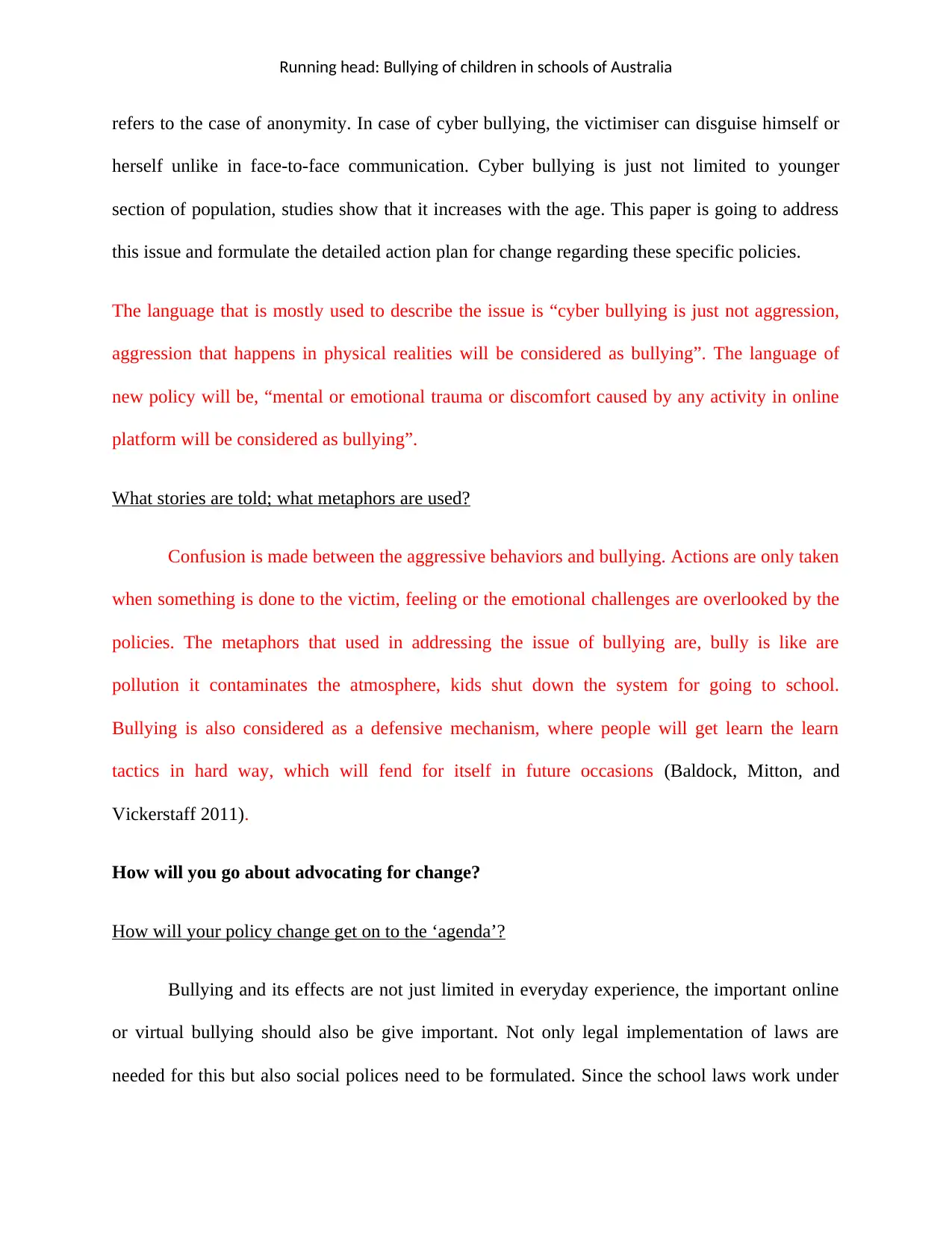
Running head: Bullying of children in schools of Australia
refers to the case of anonymity. In case of cyber bullying, the victimiser can disguise himself or
herself unlike in face-to-face communication. Cyber bullying is just not limited to younger
section of population, studies show that it increases with the age. This paper is going to address
this issue and formulate the detailed action plan for change regarding these specific policies.
The language that is mostly used to describe the issue is “cyber bullying is just not aggression,
aggression that happens in physical realities will be considered as bullying”. The language of
new policy will be, “mental or emotional trauma or discomfort caused by any activity in online
platform will be considered as bullying”.
What stories are told; what metaphors are used?
Confusion is made between the aggressive behaviors and bullying. Actions are only taken
when something is done to the victim, feeling or the emotional challenges are overlooked by the
policies. The metaphors that used in addressing the issue of bullying are, bully is like are
pollution it contaminates the atmosphere, kids shut down the system for going to school.
Bullying is also considered as a defensive mechanism, where people will get learn the learn
tactics in hard way, which will fend for itself in future occasions (Baldock, Mitton, and
Vickerstaff 2011).
How will you go about advocating for change?
How will your policy change get on to the ‘agenda’?
Bullying and its effects are not just limited in everyday experience, the important online
or virtual bullying should also be give important. Not only legal implementation of laws are
needed for this but also social polices need to be formulated. Since the school laws work under
refers to the case of anonymity. In case of cyber bullying, the victimiser can disguise himself or
herself unlike in face-to-face communication. Cyber bullying is just not limited to younger
section of population, studies show that it increases with the age. This paper is going to address
this issue and formulate the detailed action plan for change regarding these specific policies.
The language that is mostly used to describe the issue is “cyber bullying is just not aggression,
aggression that happens in physical realities will be considered as bullying”. The language of
new policy will be, “mental or emotional trauma or discomfort caused by any activity in online
platform will be considered as bullying”.
What stories are told; what metaphors are used?
Confusion is made between the aggressive behaviors and bullying. Actions are only taken
when something is done to the victim, feeling or the emotional challenges are overlooked by the
policies. The metaphors that used in addressing the issue of bullying are, bully is like are
pollution it contaminates the atmosphere, kids shut down the system for going to school.
Bullying is also considered as a defensive mechanism, where people will get learn the learn
tactics in hard way, which will fend for itself in future occasions (Baldock, Mitton, and
Vickerstaff 2011).
How will you go about advocating for change?
How will your policy change get on to the ‘agenda’?
Bullying and its effects are not just limited in everyday experience, the important online
or virtual bullying should also be give important. Not only legal implementation of laws are
needed for this but also social polices need to be formulated. Since the school laws work under
⊘ This is a preview!⊘
Do you want full access?
Subscribe today to unlock all pages.

Trusted by 1+ million students worldwide
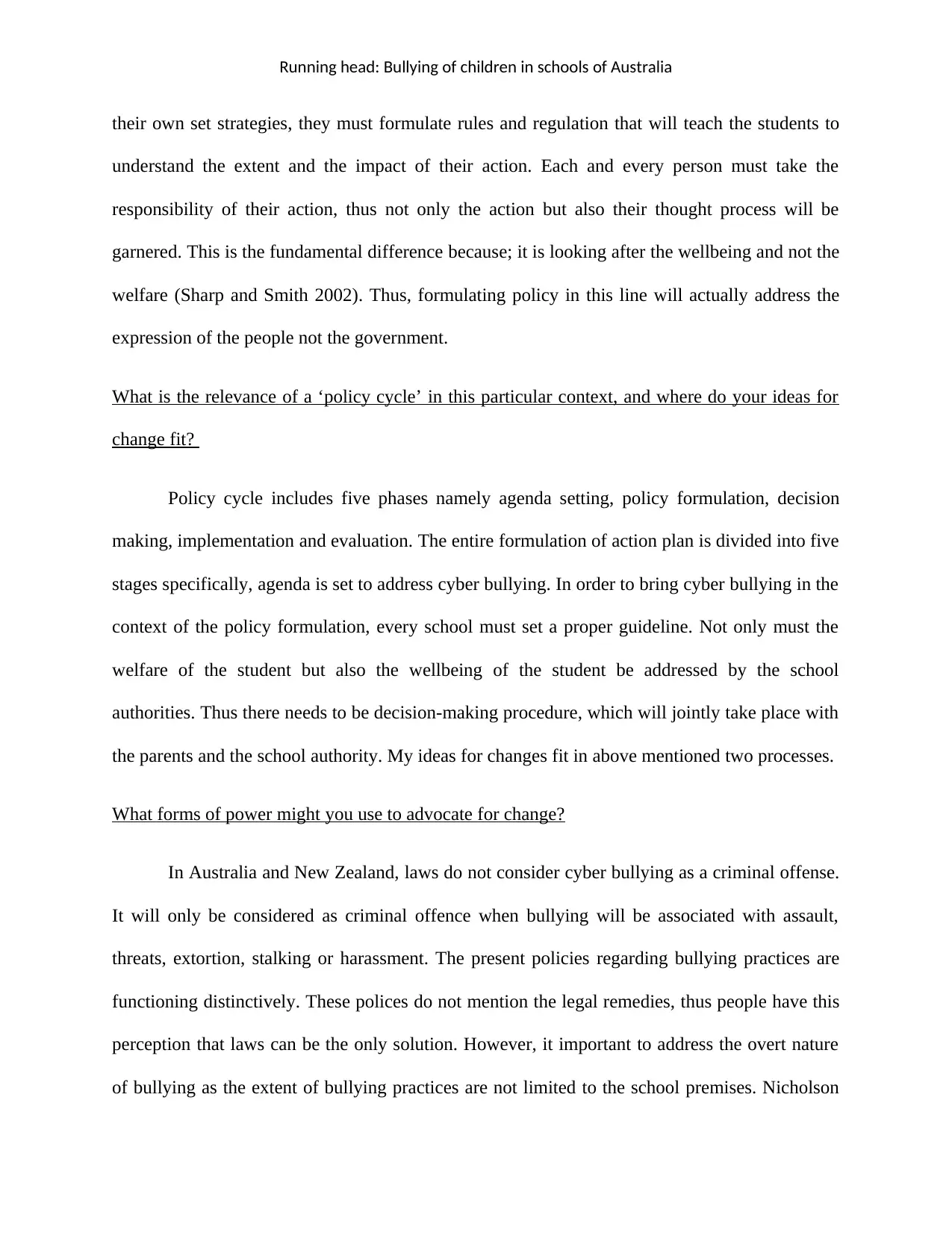
Running head: Bullying of children in schools of Australia
their own set strategies, they must formulate rules and regulation that will teach the students to
understand the extent and the impact of their action. Each and every person must take the
responsibility of their action, thus not only the action but also their thought process will be
garnered. This is the fundamental difference because; it is looking after the wellbeing and not the
welfare (Sharp and Smith 2002). Thus, formulating policy in this line will actually address the
expression of the people not the government.
What is the relevance of a ‘policy cycle’ in this particular context, and where do your ideas for
change fit?
Policy cycle includes five phases namely agenda setting, policy formulation, decision
making, implementation and evaluation. The entire formulation of action plan is divided into five
stages specifically, agenda is set to address cyber bullying. In order to bring cyber bullying in the
context of the policy formulation, every school must set a proper guideline. Not only must the
welfare of the student but also the wellbeing of the student be addressed by the school
authorities. Thus there needs to be decision-making procedure, which will jointly take place with
the parents and the school authority. My ideas for changes fit in above mentioned two processes.
What forms of power might you use to advocate for change?
In Australia and New Zealand, laws do not consider cyber bullying as a criminal offense.
It will only be considered as criminal offence when bullying will be associated with assault,
threats, extortion, stalking or harassment. The present policies regarding bullying practices are
functioning distinctively. These polices do not mention the legal remedies, thus people have this
perception that laws can be the only solution. However, it important to address the overt nature
of bullying as the extent of bullying practices are not limited to the school premises. Nicholson
their own set strategies, they must formulate rules and regulation that will teach the students to
understand the extent and the impact of their action. Each and every person must take the
responsibility of their action, thus not only the action but also their thought process will be
garnered. This is the fundamental difference because; it is looking after the wellbeing and not the
welfare (Sharp and Smith 2002). Thus, formulating policy in this line will actually address the
expression of the people not the government.
What is the relevance of a ‘policy cycle’ in this particular context, and where do your ideas for
change fit?
Policy cycle includes five phases namely agenda setting, policy formulation, decision
making, implementation and evaluation. The entire formulation of action plan is divided into five
stages specifically, agenda is set to address cyber bullying. In order to bring cyber bullying in the
context of the policy formulation, every school must set a proper guideline. Not only must the
welfare of the student but also the wellbeing of the student be addressed by the school
authorities. Thus there needs to be decision-making procedure, which will jointly take place with
the parents and the school authority. My ideas for changes fit in above mentioned two processes.
What forms of power might you use to advocate for change?
In Australia and New Zealand, laws do not consider cyber bullying as a criminal offense.
It will only be considered as criminal offence when bullying will be associated with assault,
threats, extortion, stalking or harassment. The present policies regarding bullying practices are
functioning distinctively. These polices do not mention the legal remedies, thus people have this
perception that laws can be the only solution. However, it important to address the overt nature
of bullying as the extent of bullying practices are not limited to the school premises. Nicholson
Paraphrase This Document
Need a fresh take? Get an instant paraphrase of this document with our AI Paraphraser
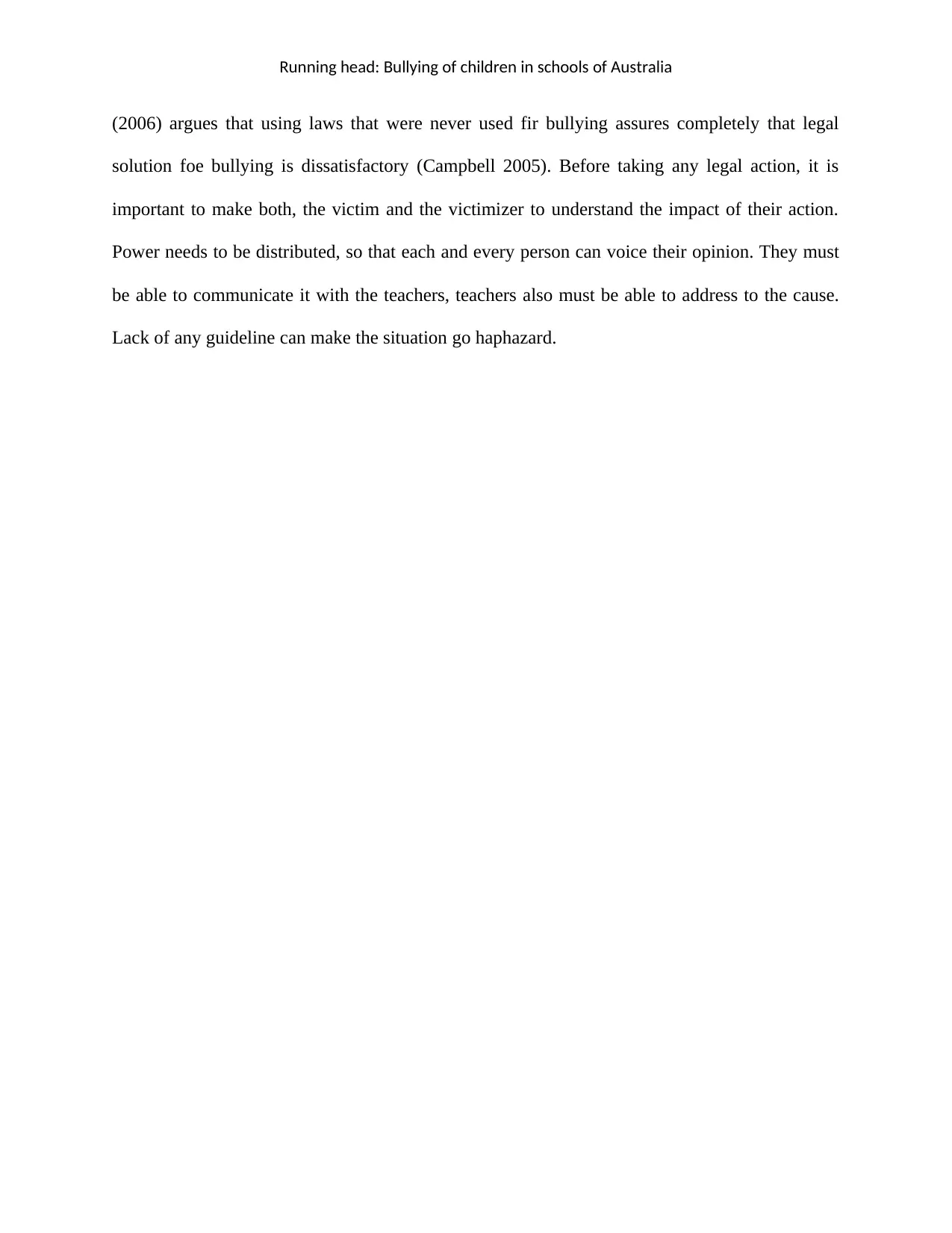
Running head: Bullying of children in schools of Australia
(2006) argues that using laws that were never used fir bullying assures completely that legal
solution foe bullying is dissatisfactory (Campbell 2005). Before taking any legal action, it is
important to make both, the victim and the victimizer to understand the impact of their action.
Power needs to be distributed, so that each and every person can voice their opinion. They must
be able to communicate it with the teachers, teachers also must be able to address to the cause.
Lack of any guideline can make the situation go haphazard.
(2006) argues that using laws that were never used fir bullying assures completely that legal
solution foe bullying is dissatisfactory (Campbell 2005). Before taking any legal action, it is
important to make both, the victim and the victimizer to understand the impact of their action.
Power needs to be distributed, so that each and every person can voice their opinion. They must
be able to communicate it with the teachers, teachers also must be able to address to the cause.
Lack of any guideline can make the situation go haphazard.
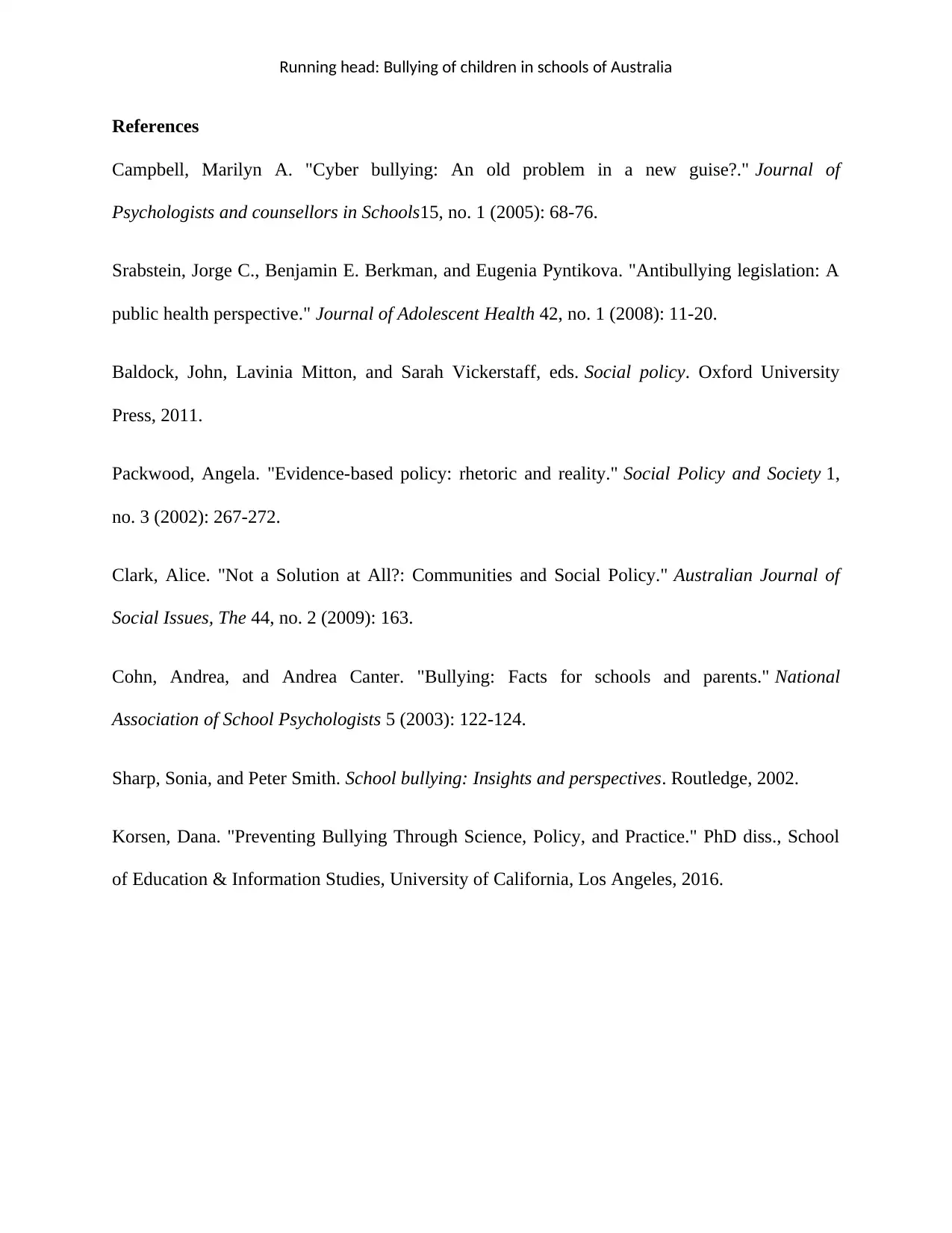
Running head: Bullying of children in schools of Australia
References
Campbell, Marilyn A. "Cyber bullying: An old problem in a new guise?." Journal of
Psychologists and counsellors in Schools15, no. 1 (2005): 68-76.
Srabstein, Jorge C., Benjamin E. Berkman, and Eugenia Pyntikova. "Antibullying legislation: A
public health perspective." Journal of Adolescent Health 42, no. 1 (2008): 11-20.
Baldock, John, Lavinia Mitton, and Sarah Vickerstaff, eds. Social policy. Oxford University
Press, 2011.
Packwood, Angela. "Evidence-based policy: rhetoric and reality." Social Policy and Society 1,
no. 3 (2002): 267-272.
Clark, Alice. "Not a Solution at All?: Communities and Social Policy." Australian Journal of
Social Issues, The 44, no. 2 (2009): 163.
Cohn, Andrea, and Andrea Canter. "Bullying: Facts for schools and parents." National
Association of School Psychologists 5 (2003): 122-124.
Sharp, Sonia, and Peter Smith. School bullying: Insights and perspectives. Routledge, 2002.
Korsen, Dana. "Preventing Bullying Through Science, Policy, and Practice." PhD diss., School
of Education & Information Studies, University of California, Los Angeles, 2016.
References
Campbell, Marilyn A. "Cyber bullying: An old problem in a new guise?." Journal of
Psychologists and counsellors in Schools15, no. 1 (2005): 68-76.
Srabstein, Jorge C., Benjamin E. Berkman, and Eugenia Pyntikova. "Antibullying legislation: A
public health perspective." Journal of Adolescent Health 42, no. 1 (2008): 11-20.
Baldock, John, Lavinia Mitton, and Sarah Vickerstaff, eds. Social policy. Oxford University
Press, 2011.
Packwood, Angela. "Evidence-based policy: rhetoric and reality." Social Policy and Society 1,
no. 3 (2002): 267-272.
Clark, Alice. "Not a Solution at All?: Communities and Social Policy." Australian Journal of
Social Issues, The 44, no. 2 (2009): 163.
Cohn, Andrea, and Andrea Canter. "Bullying: Facts for schools and parents." National
Association of School Psychologists 5 (2003): 122-124.
Sharp, Sonia, and Peter Smith. School bullying: Insights and perspectives. Routledge, 2002.
Korsen, Dana. "Preventing Bullying Through Science, Policy, and Practice." PhD diss., School
of Education & Information Studies, University of California, Los Angeles, 2016.
⊘ This is a preview!⊘
Do you want full access?
Subscribe today to unlock all pages.

Trusted by 1+ million students worldwide
1 out of 13
Related Documents
Your All-in-One AI-Powered Toolkit for Academic Success.
+13062052269
info@desklib.com
Available 24*7 on WhatsApp / Email
![[object Object]](/_next/static/media/star-bottom.7253800d.svg)
Unlock your academic potential
Copyright © 2020–2025 A2Z Services. All Rights Reserved. Developed and managed by ZUCOL.





